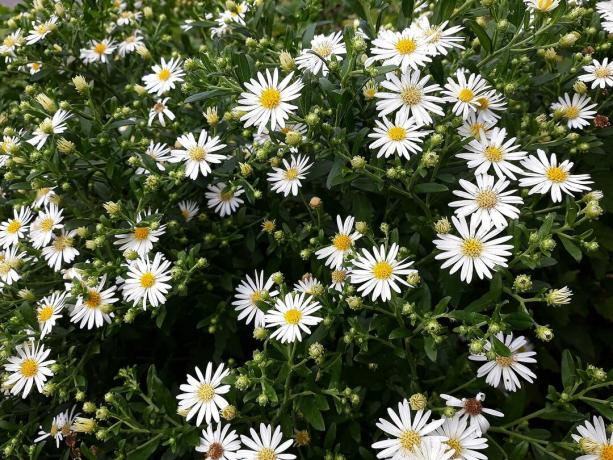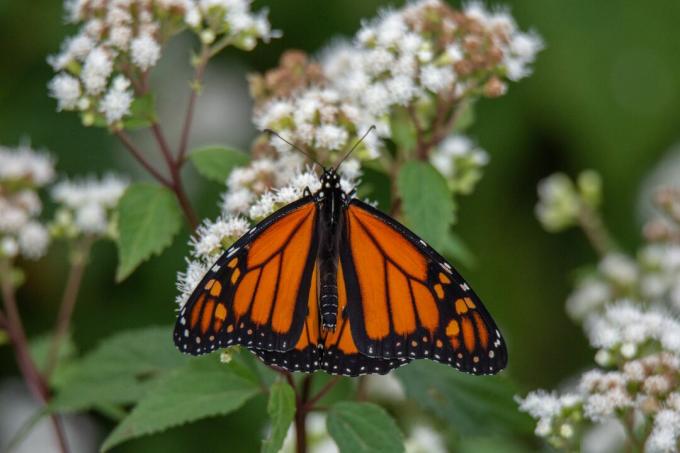Is spring the time of flowers? Thought wrong! We'll show you ten flowers that spread their blooming magic even in autumn.

Autumn is already characterized by all sorts of colors: The colorful bushes and trees in particular are eye-catching in the gardens. But among the many colorful leaves, many forget that the flowers are not idle in autumn either. In fact, many flowers only unfold their full beauty when the first leaves fall. Below are the 10 best fall flowers for your garden.
contents
- 1. Autumn flower: autumn asters
- 2. Autumn flower: chrysanthemums
- 3. Autumn flower: dahlias
- 4. Autumn flower: sedum plant
- 5. Autumn flower: autumn anemones
- 6. Autumn flower: silver candle
- 7. Autumn flower: Wasserdost
- 8. Autumn flower: zinnias
- 9. Autumn flower: sunflower
- 10. Autumn flower: heaths
1. Autumn flower: autumn asters
Whether classic white or exciting red: Fall asters (Symphyotrichum) are the autumn flowers par excellence. However, their flowering varies considerably. Depending on the variety, they bloom from spring to November. With the right choice of variety, you can see the beautiful flowers blooming in your bed almost all year round. The Alpine Aster (
Aster alpinus), for example, begins to bloom as early as May, the mountain aster (Aster amellus) then takes over the summer. But autumn is and remains the season of the aster: myrtle, pillow, or rape aster (Symphyotrichum ericoides, Aster dumosus and Symphyotrichum novae-angliae) now provide colorful beds and also offer insects one of the last sources of food before winter. At the same time, asters are also extremely easy to care for - what more could you ask for?Our 10th most bee-friendly plants see this article.

2. Autumn flower: chrysanthemums
They shine particularly colorfully in autumn Chrysanthemums (Chrysanthemum) and thus almost compete with the colorful autumn leaves themselves. The pot chrysanthemum (Chrysanthemum frutescens) popular as a balcony plant. But it doesn't look bad in the bed either. But correct care is important so that the chrysanthemum can develop its full splendor: like this the plant should be watered daily, otherwise its large leaves will droop quickly down. After flowering, the plants should then be cut back and the root balls should be protected from frost with leaves or fir branches. In summer the chrysanthemum is happy to have some fertilizer and in autumn it rewards you with its beautiful bloom.

3. Autumn flower: dahlias
With tens of thousands of different species, the dahlia (Dahlia) probably one of the most diverse plant genera at all. With the dahlias there is almost nothing that is not there. Whether white, yellow or pink, as a simple flower, round ball or prickly cactus: the variety of shapes and colors is simply overwhelming. In the garden, the colorful plants bloom from June until the first frost and are not only enchanting in autumn. Unfortunately, dahlias are not hardy: After the first frost, the above-ground, withered parts of the plant should be shortened to about 6 cm and the tuber should be dug up. This can then spend the winter in the house. More tips on Wintering dahlias You will find here.

4. Autumn flower: sedum plant
The name Sedum plant (Sedum) sounds anything but elegant and beautiful - but in reality the sedum plant is a real eye-catcher. With its numerous small flowers, which only unfold their full beauty in autumn, the sedum plant steals the show from many other plants. But not only that makes the sedum plant a perfect plant for the autumnal sea of flowers. The sedum plant is also very robust and frugal and thrives incredibly well even with little care. In addition, a large number of varieties are perennial and winter hardy and thus beautify our beds over many years.

5. Autumn flower: autumn anemones
Filigree and beautiful: The Fall anemone (Anemone hupehensis) is simply a must among autumn flowers. Its delicate flowers shine in white, pink or red from July to October. The white fruit clusters that many varieties form in autumn are also extremely decorative. In contrast to many other autumn plants, the autumn anemones like a partially shaded location, but can also thrive in the sun. A sufficient supply of water is particularly important for them - waterlogging should still be avoided. Otherwise, however, the autumn anemones are quite robust. When it comes to growth, the autumn anemone (at the beginning) is quite slow: it takes almost two years to grow properly. After that, however, the autumn anemone forms runners and can spread over large areas relatively quickly if it is not divided regularly.

6. Autumn flower: silver candle
Even if the silver candle (Actaea) is popularly called "bug herb" or "woman's root", the plant is anything but a bland, inconspicuous plant. Especially friends of classic elegance will be enchanted by the silver candle with its white, cream or pink color and the filigree flowers. But despite its inconspicuous grace, the silver candle with a height of 120 to 200 cm and its beautiful flower candles immediately catches everyone's eye. Depending on the variety, the silver candles show their beautiful flowers from June to October. Taking care of them is rather uncomplicated for such a beauty: the silver candle is very durable and robust and therefore needs little attention.

7. Autumn flower: Wasserdost
At the Wasserdorst (Eupatorium) The name says it all: It is particularly popular as a pond or border planting. With over 40 known varieties, there is something for every garden: The size of the plants varies from 80 cm to 300 cm. But also with the colors everything is available from delicate pink to pure white to strong blue. From the filigree individual flowers, tubular flower heads are formed, which in turn are composed like an umbel and transform the plant into a real eye-catcher. Also useful insects like Bees and butterflies are almost magically attracted to the water feast. The water dost is not only a beautiful autumn flower, but also helps the small insects to stock up on their winter supplies.

8. Autumn flower: zinnias
True, they are Zinnias (Zinnia) not as well known as many other autumn flowers - but their appearance is in no way inferior to them. Zinnias come in all sorts of color variations and their flower shape resembles ball dahlias or chrysanthemums. The zinnia is an absolute must, especially for colorful gardens. But the sun-loving plant also cuts a fine figure in other ways: From July to October the beautiful flowers bloom in all their splendor and really beautify every garden. The zinnia is also very easy to care for and can be grown without any problems. It just doesn't like waterlogging at all, but it gets along well with dryness. Unfortunately, the zinnia is not hardy and has to be sown again every year to beautify the garden.

9. Autumn flower: sunflower
If you already miss the long sunshine from summer, you can simply bring a little sun into the garden. The sunflower (Helianthus annuus) is probably known to every child and shines almost as beautifully as its namesake, even in cloudy weather. Especially its bright yellow flowers, but also its stately height of up to 3 m make the sunflower one of the autumn flowers par excellence. It blooms from June to October. But the sunflower does not only cut a good figure in the garden: The sunflower is also in great demand as a starting material for decorations. And then in the kitchen the flower unfolds its full potential - in September the delicious ones can Sunflower seeds are harvested, which are excellent as muesli, bread but also as a snack for in between meals taste good.

10. Autumn flower: heaths
Although they are not among the plants with the largest flowers, heather should be in every good autumn garden. This is not only because the plant is extremely decorative - varieties like the bell heather (Erica gracilis) only bloom when most of the flowers have drooped their heads. From September to December the heather shines with its small flowers and beautifies every bed. But also the Common heather (Calluna vulgaris) is not to be despised for a beautiful autumn garden. Flowering begins in August and continues into November. What is special about this is that the flowers remain in the bud stage and do not open up. As a result, the small dots of color cannot fade and are a real bright spot even on cloudy days.

Autumn flowers need enough nutrients for a rich bloom. You should therefore use a high-quality organic soil like ours for planting Plantura organic potting soil. This comes completely without peat and contains all the important nutrients for strong and strong plants.
